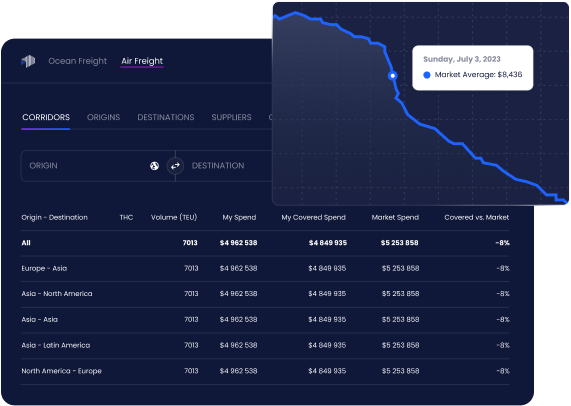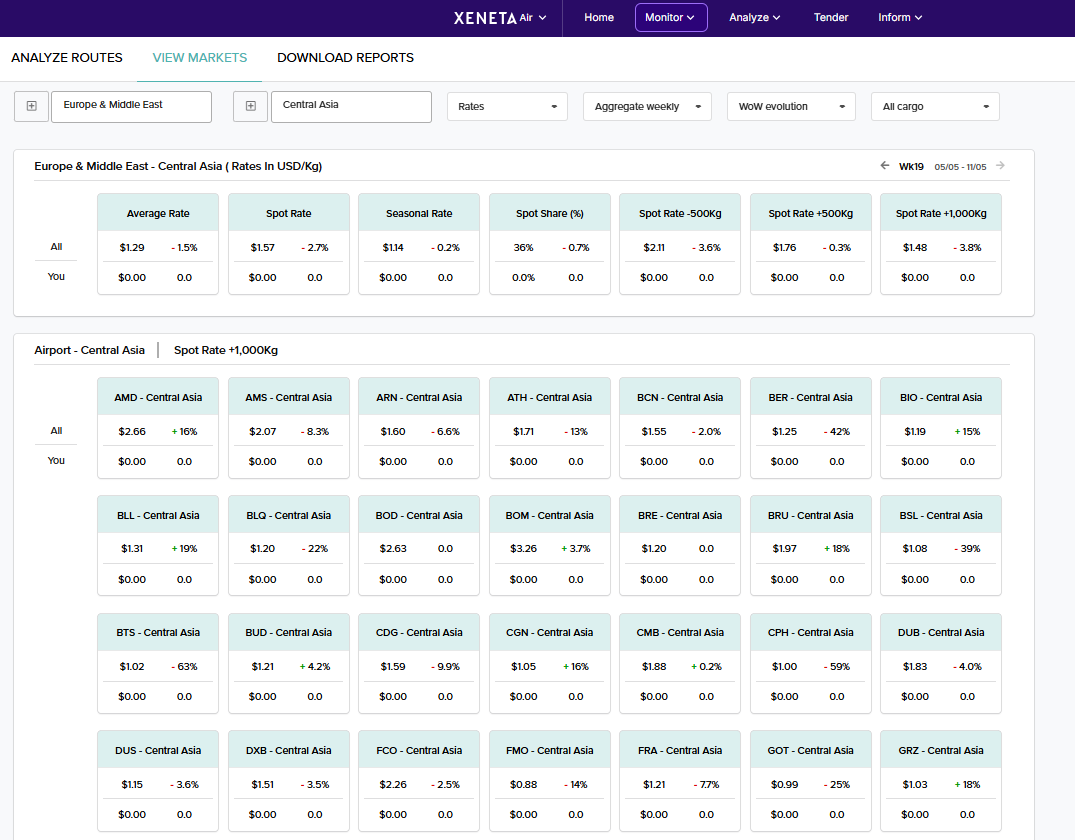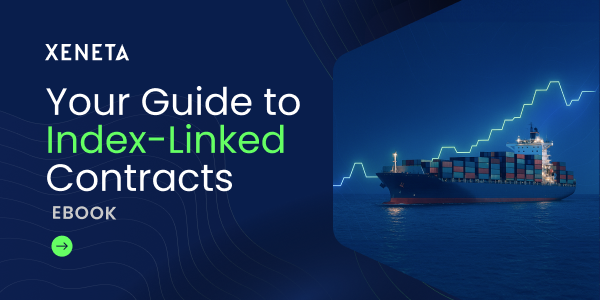Air Freight Calculator: Calculate Shipping & Freight Costs
Unlock the true long-term market average for Air Freight (1 metric ton) on your key trade lanes
Instantly calculate your freight costs
What impacts your air freight rates?
Freight rates are highly sensitive and fluctuate due to a variety of factors.
Route Distance & Connectivity
Chargeable Weight
Market Demand & Capacity
Geopolitical Events
Air Freight Analytics
Explore Our Air Freight Solutions
The proactive way to monitor the air freight market in real-time
Benchmark your air freight rates against prices sourced from other shippers and freight forwarders to see how the market has developed and where your rates are spot-on or far off.
With Xeneta-exclusive insight into load factor and capacity, you’ll have the ammunition you need to find the most time-efficient, cost-effective route to ship your air cargo.

The deepest level of air freight data available—anywhere.
Air Freight Advanced presents a unique set of data sourced directly from the world’s leading airlines. With these figures, you can get a better understanding of both buy and sell rates, as well as see the figures airlines present vs. shippers and forwarders.
Improve tendering and determine the right contract lengths with insight on capacity, dynamic load factor, volumes moved and actual shipment transactions.

Air Freight Calculator FAQs
How does the calculator work?
Xeneta's Freight Rate Calculator leverages our database of over 500 million real-time ocean and air freight rates to provide accurate, up-to-date cost estimates.
Input your corridor, approximate cost per container and industry and we’ll give you an market rate based on current benchmarks.
The calculator utilizes Xeneta's proprietary data aggregation and benchmarking methodologies to deliver precise insights tailored to your specific trade lanes.
How are air freight rates calculated?
Air freight rates are influenced by a variety of factors including distance, cargo type, chargeable weight, service level, surcharges, and prevailing market conditions. A common formula for calculating air freight cost is:
(Base Rate + Fuel Surcharge + Security & Other Fees) × Chargeable Weight + Additional Services
Here’s a breakdown of key cost components:
Base Rate
The core rate for transporting goods between airports, usually based on chargeable weight and route.
Surcharges
Additional fees such as fuel surcharges, security fees, airport charges, and war risk premiums.
Chargeable Weight
Air freight is priced using either the actual weight or the volumetric weight, whichever is higher.
Volumetric weight is calculated using the formula:
Length × Width × Height (cm) ÷ 6,000
Handling & Documentation Fees
Charges for cargo handling at origin and destination airports, including customs processing, warehousing, and documentation.
Market Dynamics
Rates fluctuate based on factors like seasonal demand, capacity shortages, geopolitical disruptions, and global events impacting air cargo.
Why has shipping air freight become so expensive?
Air freight is inherently more volatile and sensitive to disruption than ocean shipping, largely due to the speed, complexity, and elastic nature of its capacity. As global supply chains grow more interconnected—and more fragile—external shocks can trigger immediate and significant price surges.
Several factors contribute to the rising costs of air freight:
Increased Demand
E-commerce growth, just-in-time manufacturing, and urgent shipments (e.g., medical or high-value goods) have driven sustained demand for air cargo capacity.
Limited Capacity
Unlike ocean freight, air cargo space is highly constrained—especially since much of it rides in the belly of passenger planes. Flight cancellations or route reductions drastically reduce available capacity.
Fuel Prices
Jet fuel is a major cost driver. Sharp fluctuations in fuel prices are passed directly into freight rates via fuel surcharges.
Geopolitical & Regulatory Events
Airspace closures, customs changes, security regulations, and trade policy shifts can restrict routes and drive up costs.
Xeneta’s platform gives you visibility into these volatile market dynamics, with real-time rate data and benchmarks across thousands of air trade lanes. This empowers logistics and procurement teams to navigate uncertainty with confidence and make smarter, data-driven decisions.
When can I access live freight rates?
You can access live air freight rates and trends directly through the Xeneta platform.
Powered by data from millions of rates across thousands of global air trade lanes, Xeneta provides real-time visibility into market movements—helping you benchmark rates, track volatility, and negotiate with confidence.
Use Xeneta to:
-
Explore rates by origin and destination airport
-
Compare spot and long-term pricing
-
Monitor rate trends over time
-
Make informed, data-driven procurement decisions
For accurate, lane-level air freight insights, the Xeneta platform is your trusted source.
Do you have a calculator for ocean freight?
Yes, we do! Our Ocean Freight Calculator gives you access to data-driven insights into global ocean freight rates, based on 40' dry container sizes.
How is Xeneta's data sourced?
Xeneta's data is derived from a comprehensive and neutral aggregation of freight rates sourced from a broad user base, including shippers and freight forwarders.
This data encompasses both short-term and long-term rate contracts, with updates ranging from monthly to multi-year agreements. To ensure reliability, Xeneta requires a minimum of five valid rates per route, per day, per equipment type before releasing any market information. For mature trade routes, this often translates to several hundred valid rates per day, enhancing the accuracy of their benchmarks.
The data is organized using Xeneta’s Geo-Hierarchy, which groups ports based on pricing correlations rather than geographical proximity. This methodology allows for precise port-to-port pricing insights, particularly in regions like North Europe and the Far East. Additionally, Xeneta employs statistical sampling to capture market tendencies, ensuring a broad and representative dataset.
Xeneta anonymizes all collected data, ensuring that no company-specific rates or supplier names are disclosed. This approach adheres to EU/EEA competition laws, promoting transparency without compromising market competition.
For more information read the Xeneta methodology.
.png)





